
One monkey will not see, the other will not listen, and the third will not say anything, - that way it has not told us anything.
"We have nothing written about our group-home. Nothing that shows what kind of
personnel we got, how we work, andwhat our goal is. When Hans was about to move in, he
came together with his mother and looked. We told himwhich room he was supposed to live in
and what routines we had. But we do not have anything to give those who are interested in
our work, something they can take with them. We would really like to have something in
written, on account of other reasons as well. When our activity is being questioned, we
cannot defend ourselves."
(Told by a manager of a group-home 1995)
"Although I like to read and write very much, after ten years in special school
(as a teacher), I was hardly able towrite anything down. And if I wrote something, I had a
hand-writing that did not look anything like the one I had as an upper secondary school
pupil."
(Said by Arne Svensk)
The whole of this book is, in itself, a plead for documentation and its importance. We
believe in documentation as a way to be clear, be able to meet other people, inspire each
other and create new knowledge. It does not matter if the documentation is in speech,
writing or image, but it shall have a clarity that will make it possible for one person to
give the documentationto another without creating a lot of misunderstandings.

One monkey will not see, the other will not listen, and the third will not say anything, -
that way it has not told us anything.
In the picture above the anti- documentation monkey does not want to tell us anything. We want to remove the hands from its mouth. We believe that you have to see, hear, and speak out- otherwise you will not be able to move on, neither inside yourself nor outside in the world.
Bodil, let us move straight on, into a conversation about knowledge and documentation. You used to say that knowledge ought to be communicable?
" Yes, and I want to go further; I say that what you cannot communicate is not (yet) knowledge. Knowledge is supposed to intersect (go through) time and space. It is supposed to be formulated in a way that it can be used by someone else. Sometimes, in connections concerning handicap-technology, I used to think that it would be better to communicate knowledge to disabled persons than give them already completed technical products.
It is a pity that knowledge so often is invisible. Consider, if you could have
inaugurations in "the house of knowledge" just the way you have in, for example,
"the house of technology". Consider if you had antennas, which you could put up
sometimes (and were as visible as a new dress is to the environment) when you want to
show: Look, this is "the new stuff", something I can do todaythat I could not do
yesterday!"
The work making knowledge visible goes through many roads. One is about practise your own consciousness, another to convey knowledge to the environment, inspire and exchange experiences.
What is it then that ought to be documented in special schools and the care of differently abled people? We believe that you have to start very concrete, with examples, examples, examples and a careful structure. Simply, give the examples power.
But Arne, you used to talk about the "unpower" of the concrete example, in the care of the differently abled people and special school?
" Yes, I do not think the example has had any status. Sometimes it has been used to show how tough you had it, or to visualize a certain situation. But using examples to bring out new knowledge, that is something we have not done. Actually it was you, Bodil, who was the first person who listened to my examples and told me there was substance in them. I wonder why? "
Bodil, was it because it was like a new world to you? Or was it because you believed the examples had validity also within other domains?
"No, it was because I had an infinitive feeling that it would be possible to
structure your examples to new knowledge about, and for the differently abled. It was
through our conversations about your examples you became able to formulate your six
criteria on good technology for differently abled.
 |
This is how we, together wrote the book "Technology and differently abled people", which contained among other things these criteria and a number of examples about them. And you know whathas happened. A lot of people have started to catch on their examples on your lines, on your criteria. It is difficult to move from 0 example to 1. But it is easy (and funny) to come up with a fourth example when someone already has given you three other examples. There also exists a more cultural dimension to the fact that people enrich each other with examples and theories, a dimension I would like to call "mental hygiene"." |
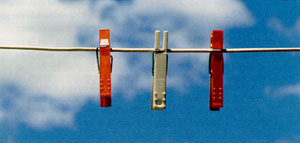
In the same way clothes-pegs need a clothes-line to be put on, examples need lines of
structure to be visible. It is easy to put in a fourth example if there already exists
three other examples.
What is "mental hygiene?"
"Well, two persons can never entirely share an experience. They both have to find
out for themselves. But you can share thoughts if they are well formulated, and sharing
thoughts is very important. It touches the string of life in human solidarity. Just think
how it is with thoughts you cannot share. Have you ever been together with a person who is
mentally ill and who looks upon things entirely different from the way you do? It will not
take long, guaranteed less than an hour if you are not used to it, before you start to
doubt whose reality is "real". What is it then that makes you sure? Well, you
are able to go out and meet people who look upon things approximately the same way you do.
The person with mentally diseases tries very much the same way- he also walks around and
tries to compare his/hers perception of reality to others- but without any success. What a
terrible destiny, what a source to confusion."
The need for mutual perception of reality is the reason for a lot of the human race's search for knowledge. When science is at its best it refers to this: we will be able to agree on how reality looks like, seen from a certain point of view. You can never look upon the whole of the reality in one way, at least not without being foolish.
Our way of thinking is crucial for what we can experience. There are people who say
that facts are forever while theories are transient. But it is rather the opposite. A
theory, even an old one, can always be brought back to life, but what facts you can
observe is totally dependent on your way of thinking. Let us give you an example.
EXAMPLE
Knowledge does not always have to be formulated in a stringent way to be used by someone else. In real close fellowship knowledge can be shared and be tacit knowledge. The shortest correspondence in history took place between Victor Hugo and his publisher. Victor Hugo`s Les miserables had just been published. Hugo wanted to find out how the book was selling while he was on holiday. His letter to the publisher read: "?" The publisher answered:"!" The reason why the letters could be so short but still say very much is due to the fact that the persons involved had a very clear implicit mutual background for the correspondence.
The"?" and the "!" contained a lot of information for those involved but were completely incomprehensible for the rest of the world. It was as it usually is with tacit knowledge- where the knowledge is, there it is, and there it can be permitted to be implicit. In a family or a school-class that accompany each other for a long time you can systematically develop your tacit knowledge so you quickly can take collective "mind-jumps". But outside the fellowship there is no knowledge.
If the fellowship is too small, stagnation will easily rise. Isn't that what you usually say, Arne?
"Yes, why should you, in a personnel-group in a group-home, tell each other examples? Everyone has experienced very much the same, so what is there to tell? Why should anyone be bothered to listen to anyone else? But it was helped when you, Bodil, started to tell me that there is a connection between the examples. A connection it could be worth looking for. At the same time I know there exists a certain contempt in problemizing and being analytic. You should not be too theoretical. Very often that is correct, but when it comes to people who have special needs I do not think common sense is sufficient for supporting them, in their very often chaotic world. You cannot speak logically to a person who is scared stiff of,for example, the reflection on the door-knob or the shadow of a tree.
On the other hand, the lack of problemizing maybe is due to what we are looking for when we are advertising for nurses. We are looking for, and getting people with their feet on the ground. It is nice with confident people, but it would make a difference with certain eccentricities and a libero"
Don't you think we are just a little too far away from the heading "documentation" now?
"No, absolutely not. I think it is very important to emphasize the background to
why there isso little documentation, that is, emptiness of theories and examples in the
activity concerning people who are differently abled. It is not until we are able to see
the background that we can move on. And of course when we know why we want to move
on."
The crux of the matter in documentation is to be aware of its purpose, its "in order to". Documentation can be a negative experience for a persons integrity, and it has, in those contexts we talk about here, often been criticised from that point of view. According to our opinion the present lack ofdocumentation prevails the emergence of the only integrity worth protecting, that is, the personal integrity. Let us take a close look at the documentation front, its "in order to".
First something generally about a teleological (purpose) approach versus a mechanistic (cause) one. If a little child, in old Greece, asked "Why is there an acorn here?", the answer would have been:" There is an acorn here because an oak is supposed to grow up". The Greeks had a teleological model for explanations. If you, on the other hand, are out today with a little kid and he asks the same question, you will answer: "My dear little friend, look up! There is an oak here. It is the oak who has dropped the acorn." In our mechanistic way of thinking cause has to come before effect.
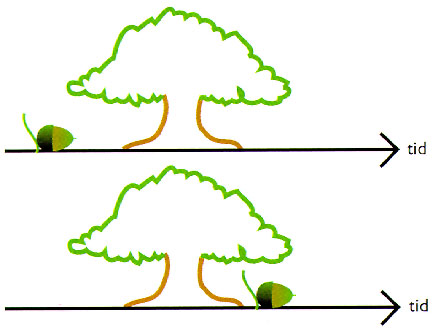
It is not wrong to say that the acorn is where it is because it is supposed to grow up to be an oak, or to say that it is where it is because the oak has dropped it. But the mind is completely diverted by the two models. If the acorn is there because it is supposed to grow up, then it does matter what I do. If it, on the contrary, is there just because the oak has happen to drop it- then the race is already run.
But consider if we can reach knowledge by looking for purpose, not only causes?
Consider if we in that way became more "economically-minded"? There are thoughts
which are good to think with, good to see with, good to listen with, good to work with.
Maybe new groups of people can be recruited to a special scool or day-care center where
clear "in order to"-signatures complement the activity's cause-signature
("because our pupils have special needs, we are supposed to do like this").
Arne,you say it is important to make the small bigger, why?
" Foremost it is important not to give people the opportunity to get away by reason about "them" versus "us". Let us extend the small to the very big and look at the six fundamental conditions for happiness that an institution of psychology has identified.
An enumeration like that takes away something of the unique position of ones intellect. Well, not only that, it is obvious to everyone that to be rich, educated, handsome or young is not among the fundamental conditions.
You can change the direction as well: from the small, the special, to the big, more generally. Freud used, for example, the slip of the tongue to draw conclusions about the flawless. Correspondingly we can learn a lot about ourselves by thinking on how differently abled persons approach things. For example can their way of dealing with death help us to look at our own attitude a bit more."
Bodil, what do you think about small and large, about the individual and the general, about examples and theories?
| "I think I want to start with one of my "mind-images". What is this? |
/ |
| And what is this? | \ |
| And what is this? | - |
OK, you might answer: A slanting line, another slanting line and a horizontal line. But if you see them together, you will see something totally different:
A
An A. Not two slanting and a horizontal line. It is precisely the same thing with
theories and examples. The thing is to be able to go between, to walk on the crossbar,
that gives them meaning. Separate they are uninteresting. Only people, who are walking
back and forth on the crossbar,can make the documentation meaningful. Otherwise it will
miss its element of "in order to"."
Use pictures and examples when you make documentation. One good example says more than a thousand words. It can be about the events you have succeeded to depict, concrete and free from valuations. It can also be about examples you invent for exemplifying a line of thought. A picture also says more than a thousand words. That stands for concrete pictures as well as images and analogies. Compare for example the picture on page 22 and the text below!
| The social, economic, and political significance of the biological sciences to our world today suggeststhat it should play a central role in a liberal education. Yet, at colleges and universities across thecountry, students and faculty alike are becoming increasingly dissatisfied with "Introductory Biology"courses as they are presently taught. Too often such courses are simply taken as a hurdle that must becrossed to gain access to upper-level courses, or as a requirement for entrance to professional school.Many reasons could be cited for the difficulties facing introductory biology courses (and introductorycourses in general), but three are especially apparent.The first problem is that an explosion of information makes it more difficult than ever to providestudents with an overview of biology that is at the same time accessible, useful, and an accuraterepresentation of the state of the art; it simply is no longer possible to provide an encyclopedic overviewof biology in a single course. A common solution to this problem is to subdivide introductory biologyinto two or more conceptually-independent units. At Duke, for example, one semester of the presentintroductory sequence covers "organismal and environmental biology," while the other semester covers"cellular and developmental biology." An unfortunate consequence of this approach, however, is the lossof a unifying perspective on the subject as a whole. A second, related problem is to find faculty willingto teach across a broad spectrum of the discipline. A common solution here is the use of team-teaching.At Duke, as at many comparable institutions, we now have many lecturers (up to ten each year)involved with the introductory course, each responsible for only one compartmentalized section ofmaterial. Differences in style and lack of coordination, however, further erodes conceptual cohesivenessand confuses students who are struggling to find a "big picture." A third problem, perhaps the mostdifficult we face, is burgeoning enrollments. As class sizes grow into the hundreds, it becomesincreasingly difficult to introduce classroom innovations, or even to imagine reworking a curriculum in ameaningful way. These problems have led the Botany and Zoology departments, working closely withthe CTL, to try a new approach to teaching introductory biology at Duke. We hope to achieve severalobjectives. The first, of course, is to present biology as an intellectually cohesive discipline and to givestudents a better understanding of the significance of modern biology as one facet of an integrated liberaleducation. We hope to endow students with an appreciation of how new information is acquired andinterpreted, as well as an understanding that knowledge constantly evolves. Secondly, we want to createa "small-group" learning environment embedded in the context of the course as a whole, to takeadvantage of the many pedagogical techniques that may be introduced in this context, such as anemphasis on writing. Lastly, we want the introductory biology course to serve as a model trainingground for new teachers. This will not only provide our graduate students with a better way to honetheir teaching skills, but it also will take advantage of the considerable talent and energy they alreadypossess to help the course achieve its other goals.A central feature of our new approach really is an old idea -- having a single professor responsible forpresenting the entire course to students, to ensure continuity and intellectual coherency. But thisapproach carries with it a number of serious burdens, and it is here where the active involvement of theCTL will help us move the project forward. For example, one fundamental issue is to decide on arepresentative curriculum. What topics must be included, and why? What can be presented withsupplemental materials? What can be left out entirely? If asked to come up with a syllabus, any tenbiologists most likely would come up with as many answers. What is considered to be "IntroductoryBiology" is not codified, and perhaps never will be. The CTL will serve as a "think tank," coordinatingthe exchange of information and ideas among many faculty, both from Duke and elsewhere, who canand should contribute to the intellectual framework of the new course. Beyond content, the CTL alsowill play a central role in helping us to develop and implement new methods to be brought to the class --such as interactive computer learning tools and the use of other online media -- that will enable us toprovide a more integrated curriculum than would be possible through the traditional use of lecturesalone.Another major feature of our proposal is to substantially rework the role of graduate teaching assistantsin the introductory course. To this end, the structure and function of the laboratory portion of the coursewill be radically changed. We will limit the size of laboratory sections to 12 students and have eachsection taught by a single TA. More significantly, we will reduce the length of laboratory periods fromthree and a half to two hours, and introduce a separate one-hour "seminar" session each week. Theseminar/laboratory meetings will provide the basis for a small-group learning experience embedded in thestructure of the larger course and provide an excellent opportunity for enhancing the training of graduatestudents as teachers. Accompanying these changes, however, will be the need for added support forTAs in the course. Here, too, we will work closely with the CTL to develop a customized skills programfor TAs working in the introductory biology course, one that is interleaved with the TAs' teaching andpreparatory time throughout the semester.This is a propitious time to revise the introductory biology program at Duke. Our problems are muchlike those felt at similar institutions throughout the country, and they occur at a time when scientists arerethinking their approaches to education in general. Students and their parents are becoming choosyconsumers, aware of the cost of higher education and interested in the quality of their investment.Perhaps the most important element is Duke's willingness to invest resources, such as those madeavailable by the CTL, to support new teaching initiatives for the future. (I will not take any responsability what so ever, about the text above. I found this text by accident on internet, and I haven´t even read it through… /Björn Gröhn ) |
Exactly one thousand words - look how little they say compared to a picture.
EXAMPLE
Arne:" As a manager I have sometimes met resistance from co-workers when I have wanted to change the environment in the group-homes, so they could be more comprehensiblefor the differently abled persons who live there. It is often about putting up pictures on cupboards and walls for those who cannot read, or to mark buttons on different electric domestic appliances. The staff-members have motivated their resistance by saying that the apartment would look like an institution if you started to put up pictures everywhere, " It is not normal to have it like that in a home" as someone expressed it.
Then I started to think about what "normal" is, and if we, so called, average-talented people do not use any (talent's supporting) facilities. In just a couple of hours I was able to write down approximately 50 facilities.
A selection.
Talent- and judgement facilities for average-talented
Washing instructions for clothes. You do not have to recognise different qualities.
Open-dating. Sooner you had to smell, feel and look at meat to decide whether you could eat it or not. Today we just look at the open-date and swallow everything.
Thermometers (meat, odoor, inside, fever). You do not have to feel for yourself.
The dashboard in your car; speedometer, warning lamps for oil and battery.
Souvenirs, so you remember where you have been.
Reviews on films and books, so you do not have to do a quality-judgement on your own.
Contraceptives.
Cookery-books with colour-pictures.
Warning-signs. You do not have to study the moose yourself, you just look at the sign that says: moose 500 metres.
State- and municipal controls on gold, water and electricity articles.
Automatic cameras, so you do not have to adjust distance or light.
Weather forecasts, so you will not have to go out in the middle of the night to study cloud formations, thecolour in the sky or a swallow in flight- you only have to look at the TV.
Thermostat on irons.
Pools experts. (football)
Already chosen channels on the radio and systems that look up your favourite programs automatically.
Electrical fuses. You do not have to keep in mind how much you burden the mains.
Photographs and video films to help your memory.
A ready button on chickens. When the button goes up the chicken is ready.
Quality auctions that guarantees you will not ruin yourself by buying a new painted Turner.
Operating instructions.
Watch, scale, map, compass, measuring-tape, etc. etc. etc.
Those cognitive aids for average-talented people are so obvious that we usually do not think of them as aids. An advantage about them are that they are saving time, because you do not have to work or study a lot to search for knowledge in those fields. Some of these talent-facilities can, of course, differently abled persons use, but a lot of these facilities are too abstract. By that, the strange situation arises that those who need the talent-facilities best, that is, the differently abled, have fewer and often less well- suited talent-facilities.
This example has helped me a lot. If I had not documented the list of " talent-supporting" facilities for average-talented, I had never been abled to communicate my wonder about the up-side down world to others".
Made- up fantasy examples can be effective to challenge already existing blinkers and prejudice:
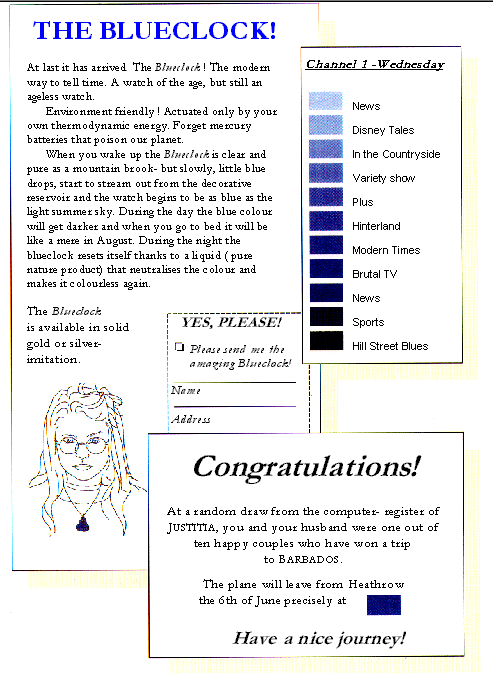
EXAMPLE
Maybe you need some support of imagination to understand how hard the "hour-watches"could be for the differently abled? Then take a trip to the land of the blueclocks and meet the mind-construction the blueclock (page 28). It is the watch for the blueclock people- it does not measure time in minutes and hours but in a scale of blue. Of course you have the possibility to buy watches in the land of the blueclocks through a mail-order firm, just as the advertisement shows.
How would it feel for you to sit with the blueclock in your hand and from its scale of blue try to understand a TV-guide? How would you deal with the possibility to go to the West-Indiesthe 6th of June at so-and-so blue? Probably, in a situation like that, we all would, non-stop, compare the scale of blue between the blueclock and the time of departure or the TV-guide. When it comes to the journey to the West Indies we would probably go out to the air-port already when the colour was light blue.
The hypotheses maybe seems a bit odd, but it is very likely that a lot of differently abled people feels just like that with our ordinary watches.They can learn how the hands shall point when it is seven o'clock and they are on there way to play bowling.

At the time-bar to the left one lamp at a time disappears as times goes by. When all lamps are out an hour has gone. At the Isaac-screen "now" is always at the top. You can see an arbitrary couple of hours in front of you. Every hour can be marked with numbers for those who understand numbers, and symbols for those who understand symbols.
But since they cannot understand the "watch-system" they can sit from five o'clock and look at the hands just to be sure to discover when the right configuration appears.
The blueclock example serves according to our experience an important function:
it starts peoples thoughts, it inspires, it makes you observant on other aspects in your
daily-life. It can, for example, happen that you start to work in a more active way with
different kinds of "time-facilities" for those who do not understand our
watches.
Very often you will hear that it is no use to make documentation - you can still not interpret the connections. It happens that the documented reality looks like the 39 theses below about Per. Are all 39 theses equally important? Are there any connections between them ? Are there any superior and secondary problems?Where will you start? The only result of documentation from top to bottom might be that you visualise for yourself and to others how incompetent you are. That you do not understand anything.
Read and think for yourself:
Per has no friends, either in school or in the "group-home".
He has hallucinations due to of migraine.
He will be very violent if he does not get what he wants.
He often dresses himselfin womens-clothes.
His dad was very violent at home against Per and his sisters.
Per is almost average-talented but he refuses to go to school.
His biggest interest is guinea-pigs, and his room is filled with cages.
He can go by bus, but he does not because he is afraid of migraine attacks.
Before he was 15 years-old he had lived at six different institutions.
The parents do not want Per to come home at week-ends but Per wants to.
The staff-members are afraid of him. Especially the women want him to leave.
Per sometimes refuses to wash himself for weeks.
He likes all kind of food and is able to eat a lot. At the moment he is 246lbs.
He sometimes falls into a state of psychosis, when he feels haunted and humiliated.
If there are demands, for example that he shall wash himself, he can lock himself up for days in his room.
Per walksin and out in his friends rooms.
He has great difficultiesin speaking and understanding the language and certain usual words he does not understand at all.
At week-ends it happens that Per refuses to go to an activity therby the others cannot go either- the lack of personnel makes it impossible.
Per is economical as well as wasteful. He can pay hundreds of dollars for certain things, but sometimes he feels he cannot afford a chewing-gum.
Per has sometimes difficulties in separating migraine-attacks from nightmares. This makes him confused.
At nights Per can sit and talk on the telephone for hours with people he met many years ago. This gives him huge telephone bills which he refuses to pay.
Sometimes when Per has made up his mind to do something special, for example go shopping, and this is not possible, he threatens the others to get his will through.
Not a single staff-member likes Per, and he can feel that.
Sometimes it feels like Per uses his migraine-attacks to get his will through, for example in a shop.
Per is afraid of small children because they can tease him.
He is very caring towards his guinea-pigs and look after them meticulously.
Because of his migraine-attacks Per get a lot of medicine which changes his personality.
Per's sisters are all average-talented and have jobs.
Per does not like to watch TV at all.
Per'sbiggest interest except guinea-pigs is music.
If you try to balance a budget with him, he will agree, but he will surrender as soon as it suits him.
Per thinks he knows better than everybody else.
Per demands to change rooms with Sven to make room for more guinea-pigs, but Sven does not agree. Per then threatens Sven.
Per sometimes gets scared when you tell him that he has made progress. He is afraid of praise.
Per often phones home to staff-members that is not on duty, to use them against personnel on duty. It is usually about money.
Per is not afraid to go to the dentist, even if it is a major treatment.
Per would never think about buying birthday presents for his friends at the "group-home", but if he does not get any, he will be furious.
If there is not enough food, Per makes sure he gets what he wants. Then the other have to share the rest.
If you conclude an agreement with Per he makes a point of the personnel to carry out
their share of the deal. He considers himself to have the right to break his promises
whenever he feels like it.
The very enumeration shows something very central: that you as a caretaker have to practise your proficiency. You have to discover that Per has the migraine even when he does not tell you. You must be able to meet Per when he is violent. To know how to do this demands something extra.
To the proficiencies ought to belong knowledge about how to invent such a technique you
can use as a support.
1. Do you think a board like that one on page 33 can help Per?
The board contains different lines, which you can put pictures on. When you press a line, a voice says for example "bicycle" or " I want to go out and cycle".
2. Do you think the voice should be known or unknown to suit Per?
3. What do you think will happen if there already from the beginning exists two squares, one that says "DON'T WANT TO" and the other, which you can use if the personnel is nagging, says "I ABSOLUTELY DON'T WANT TO"?
4. Or maybe you think that Per should not have the opportunity to try the board at all?
It is most likely possible to develop a proficiency that makes it possible to answer the questions above from qualified considerations. This is important, because if you start completely wrong with Per, you have from the beginning taken away the possibility that could have been available.
The list with the 39 points has brought us quite far since we have been trying to use it for something. If we only had had it for looking at we would probably not get anything out of it. It is just like picking morels: those who know where the morels usually are can be successful. But those who look for fungi in general will easily miss the morels.

Arne, just once more: why is so little documentation made in group-homes and special school?
"Once, when I was working at the Telecom, I worked with a man who was incredibly inventive. He had, among other things, invented a method to nail cable indoor. It took half the time it usually does. I then asked him why he had not left his method in the proposal box. He laughed a lot- Why should he get his piece work reduced to its half and a tap on his head, when he could continue to make good money and be spared the tap?
The story above can symbolize a reason to why so little documentation is made in the care of differently abled people. The way I see it, you have very little to gain from the environment by making documentation. On the other hand, you can loose a lot- for example, it can be shown that you have done something wrong.
Another important reason is that many people within the the care of differently abled people cannot write. Some because they are dyslectics, but usually their inability is the consequence of almost no practise in writing at all.
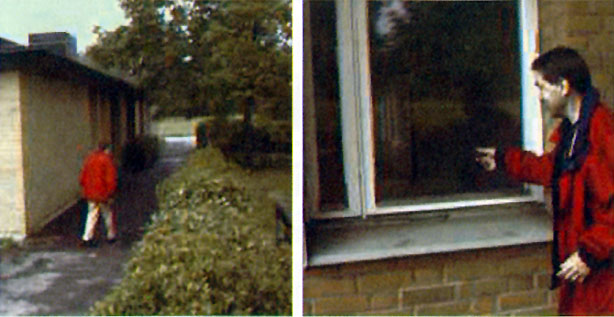

Documentation in pictures with assistance from the Isaac pocketcomputer
In spite of the fact that I like to read and write a lot, I could not after ten years in special school ( as personnel) hardly put anything on paper. And if I wrote anything I had a handwriting that did not look like the one I had in upper secondary school.
A third factor is about ideology. There was a period during the 1980s when you were not aloud to write anything about differently abled people. Especially not in group homes, "it is their home, and no one writes anything about you in your home, so why should anyone write about them?" - was the attitude.
I think this is an erroneous attitude which builds its associations on old -fashion case-book notes, that mostly contained misery. But that's not the way it has to be.Today the documentation could deal with what a person does when she wants to go out or how she shows that she has pain in her stomach. Or it could be about stories or pictures she wants to remember in the future. Naturally Isaac plays an important role in this."
All human beings need to have their story documented and made visible. Also when documentation is made afterwards, it can start special processes. Stig Nilsson, one of the Isaac- users, is doing a photo-documentation together with Göran Plato (see also the chapter future and history). This is how it looked like when Stig returned to one of the places where he had lived. A lot happens within Stig when he returns to old places. He shows this, among other things, byholding the hands the way he does in the last picture on page 35.
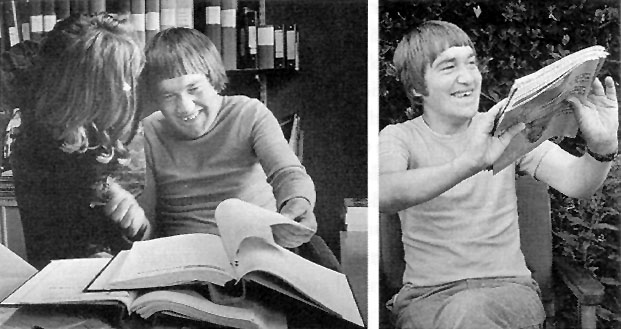
Pictures on the very same Stig have to conclude this chapter. Stig has always been interested in documentation. " In his wish to write down what he has experienced, so he can mediate his experiences from environment to environment, he illustrates his need for continuity", writes Dr Ingrid Liljeroth in her book " The mentally retarded and the the care of differently abled people". The pictures above are taken from that book.
Can the message of this chapter be expressed in a better way than Stig does when he fights to get text on paper, to get pictures, to get documentation? Events are made real to him, they are preserved and mediated through documentation. This is probably the case with us too. Even if we aren't differently abled as Stig is.
The key-words and key-messages of the chapterTo develop and be developed you ought to practise in documentation; to see, to listen and to tell. Experiences are individual thoughts can be shared. Example-silence, lack of theories, and documentation-emptiness often stick together. Pictures and examples are valuable in documentation, the concrete one as well as the invented ones. A documentation of an event ought to be done as free from evaluations and concrete as possible. Documentation can make knowledge visible and, among other things, show how you, yourself are thinking (how am I supposed to know what I think, before I have seen what I have written/heard what I have said?). Documentation can lead to the fact that needs and thoughts are made more visible through a whole series, that is you see connections that earlier were invisible. Reasons to different attitudes can appear. You can reach common ground outwards as well as inwards. Documentation can give the interplay of theory and experience that is needed for a development of activity. Today stimulation to make documentation is missing in the care of differently abled people. At the same time there are a lot of actual obstacles to documentation, for example unaccustomedness, lack of education and guidance. Furthermore there is a remaining ideological resistance from a time when documentation was equal to dictatorial case-book notes about problems. You have to see the purpose with communication, its "in order to", if it shall have the possibility to compete with other assignments. |
Next chapter: Relieving examples , or back to Table of Contents.